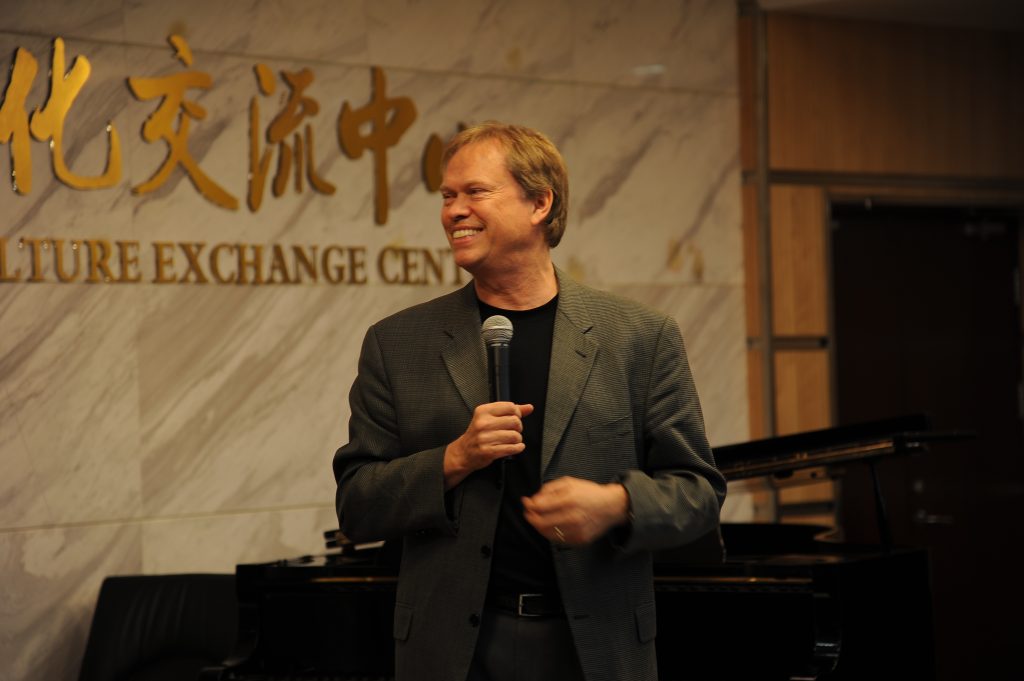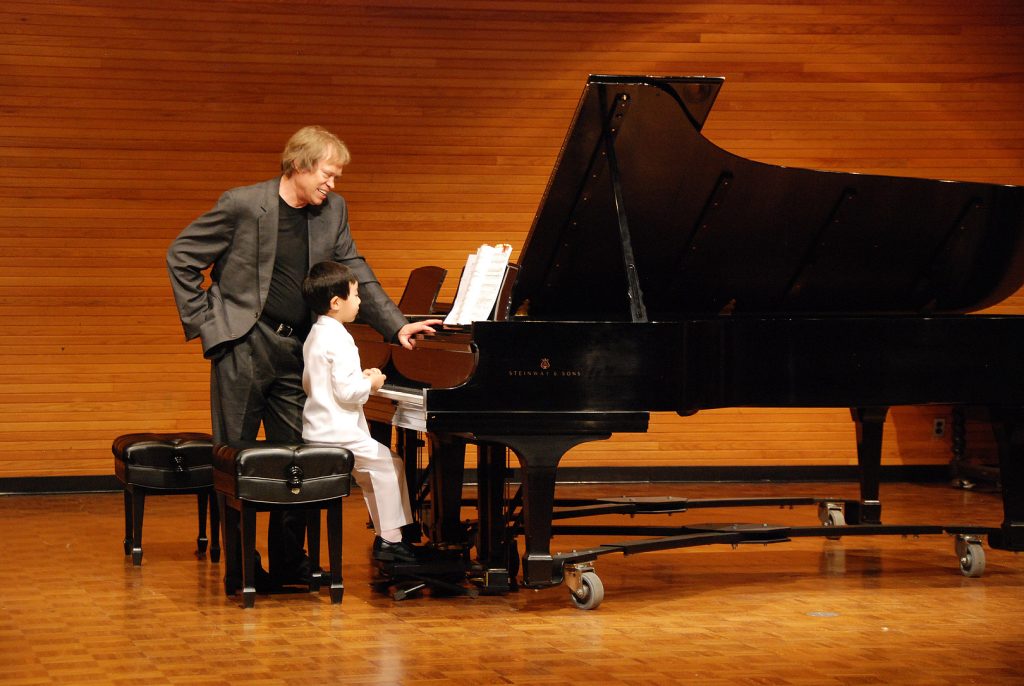Music is an Adventure – Interview with Randall Faber
Randall Faber, alongside his wife Nancy, is well-known for co-authoring the best-selling Piano Adventures teaching method. Their books, recognized globally for fostering students’ creative and cognitive development, have sold millions of copies worldwide. Previously translated into nine languages, Piano Adventures is now also available in Dutch and German. Eric Schoones had the pleasure of speaking with Randall Faber about his work and philosophy.

We share an admiration for Dinu Lipatti.
He was the first pianist who really captivated me. I remember playing Schumann’s Piano Concerto and hearing his recording, which was extraordinary—it stood head and shoulders above everything else. And in your book on zen and music making, Lipatti is the main character!
Yes, his letter on how to study is unmatched. It shows how he transformed the score into a vibrant and spontaneous performance, starting with the music itself before ever touching the piano. This approach is beneficial at all levels, from beginners to virtuosos.
I see a parallel in how we aim to engage young children right from the start, encouraging full expression and creativity. Instead of just focusing on technical training, we give them tools to express themselves.
There’s no point in learning to hit the right keys and only later adding a little music. The musical content itself should guide the practice.
Exactly. If you skip the conceptual phase, you’re just repeating what you’ve already learned, at best adding a bit of “salt and pepper” for expression. We should bring rhythm into the body, make it kinaesthetic. We use creative audio examples, singing the music, so when students approach the piano, they already have a clear concept of the musicality in their minds—just like Lipatti did. It’s a far cry from merely decoding notes and turning them into something that vaguely resembles a song. Our mission is to foster musical understanding at every level.
The early phase of learning piano might seem easy because the notes are laid out for you. But it also has the disadvantage that it’s not always easy to physically connect with the keyboard.
Yes, but one could argue that the sensory feedback from the fingers in the motor cortex is linked to spatial reasoning. This might explain why humans have historically counted on their fingers. I also feel that the physical connection to the keyboard is very closely tied to the auditory cortex.
Do you know what Joseph Hoffman said? “Eyes and ears in the fingertips.”
Exactly! In our early childhood courses, aimed at five-year-olds, we focus on building plasticity and sensitivity to develop that neural connection. Pitch, rhythm, and tactile experiences are all connected with emotion, and this emotional engagement makes music-making a true adventure.
This emotional connection seems crucial in keeping children motivated to continue their piano studies.
Yes, I did my doctoral research on the stages of talent development, and I found that people have different needs at different stages of life. For young children, fun is the main motivator. We call it the spirit of play. Five- and six-year-olds are naturally curious, constantly exploring the world and receiving feedback from it. Our job is to fan the flame of their curiosity. As they get older, motivations shift toward self-esteem and introspective questions like, “How do I fit into the world?” When a student thinks, “Wow, look what I can do!” they realize that they can develop skills through effort. They start to understand, “If I put in the work, I can achieve this.” And that’s when they begin to form their artistic identity.
In that sense, music-making can help not just in developing musical skills, but in shaping one’s personality.
Absolutely! Even if they end up in a creative field like architecture or engineering—or even in banking—there’s still a sense of artistry. While we strive to elevate the arts, sometimes the ego gets in the way. But with the really great artists, that reach out and connect with others. Like those artists, everyone eventually could transcend the ego, but during adolescence, though, it’s important to allow students to show their peacock feathers —they need that stage. It’s part of their growth.
How much of your own personal experience is reflected in your books?
I started playing at eight years old, but I didn’t have a great piano, perfect pitch, or a fantastic ear. I really had to work to develop those skills. I think starting at a young age has its advantages. We adopted our daughter from China, and music had such a profound effect on her—it was like she came to life through it. Working with her and some of her friends, we saw how music opened up a whole new world of perceptions. It was an inspiring experience for us. Of course, you can’t be more passionate about developing talent than with your own child. Watching her grow and develop was essential to writing our books.
Your own development also played a key role in this process.
I was classically trained, but as a teenager, I started playing a lot of pop music, which taught me so much. One of the first things we did when we began publishing was arranging Disney tunes. This led to materials in various styles—pop, Disney, rock and roll, Christmas songs, hymns—so young students could feel a connection to the piano by saying, “This is my book, my sound, my style.” That was the piano revolution in the ’90s, especially in the U.S.
Exploring different genres myself had a big impact on my freedom at the piano. I could improvise in pop styles, go through chord progressions, and that made it easier to understand the structure of the music when I played Brahms. Over the past couple of decades, I’ve spent a lot of time training teachers on how to incorporate songs like Disney tunes and be more free with their fingers and hands—seeing harmony as a matrix on the keyboard. Teachers often aren’t trained in that way.
Teaching is about the interaction between the teacher and the student, and your materials provide a foundation for that.
The question remains: how much can we influence a student through methodology? Yes, we have a curriculum, but it’s really up to the teacher how they deliver it. Every teacher has their own personality and style, and the key is authenticity, patience, and soulfulness. Teachers also need to remember to set aside their own egos, they should take the backseat. It’s not about leading the student, but about following their curiosity and guiding them along the way. It’s all about nurturing a love for music and growth in the child.

You’ve developed a checklist, one could say, of key topics to cover in teaching.
Yes, we’ve developed what we call the ACE triangle—Analyse, Create, and Express. These are the three components of artistry. To understand music—its structure, its grammar—students must be able to create with imagination, which sparks artistic expression. It all comes together in one organic whole, and indeed, ACE can serve as a checklist. It’s about ensuring the teaching is all-rounded: Did we touch on expression? Did we encourage creativity? Did we analyse the music, breaking down the structure of a piece like Beethoven’s, for example, and discussing its themes and harmonic progressions?
And that’s so important—ensuring the music is connected to the teacher’s and student’s feelings and personalities. You don’t want to make a student into a copy of yourself.
Absolutely! It has to be a personal, holistic experience. I’ve seen teachers in masterclasses tear a student apart in an attempt to play the piece the way they themselves would. That’s not the goal. With the principles behind ACE, a teacher can open doors for the student, allowing them to continue learning in their own way and experience their own musical adventures, which will grow and evolve over time.
More about Faber’s piano adventures at: pianoadventures.com
Text: Eric Schoones
This article is a contribution from the German and Dutch magazine Pianist through Piano Street’s International Media Exchange Initiative and the Cremona Media Lounge.
 Pianist Magazin is published in seven countries, in two different editions: in German (for Germany, Austria, Switzerland, Luxemburg and Liechtenstein) and in Dutch (for Holland and Belgium).
Pianist Magazin is published in seven countries, in two different editions: in German (for Germany, Austria, Switzerland, Luxemburg and Liechtenstein) and in Dutch (for Holland and Belgium).
The magazine is for the amateur and professional alike, and offers a wide range of topics connected to the piano, with interviews, articles on piano manufacturers, music, technique, competitions, sheetmusic, cd’s, books, news on festivals, competitions, etc.
For a preview please check: pianist-magazin.de or www.pianistmagazine.nl
Comments